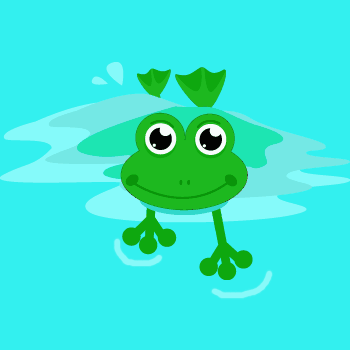Growing Independence and Fluency Design
Swimming Like a Frog for Fluency
Rationale: This lesson is created for children to better understand what they are reading and enjoy it. It is critical they learn to read fluently. Fluent reading is the ability to automatically recognize sight words and to read quickly with understanding and expression. The goal of this lesson is to teach students how to become fluent readers by teaching strategies such as decoding, crosschecking, rereading, and fast reading for understanding. They will do this by reading and rereading a decodable text, which is proven necessary for fluency development.
Materials Needed: Pencils, stopwatch for each pair of students, fluency chart for recording WPM, fluency checklist, reading tracker, reading comprehension questions, dry erase markers, sample sentences, class set of the book “Swim Like a Frog”
Procedures:
-
Say: “We are going to achieve one of our goals in becoming a fluent reader in class today. Does anyone know what a fluent reader is? (Call on student to answer). A fluent reader is someone who is able to read very quickly and smoothly because they are able to recognize the words. If we can recognize the word, then we can better understand what we are reading because we instantly know each word’s meaning. It makes reading much more enjoyable!”
-
Say: “Now let’s look at a sentence on the board: Madge likes to swim in the pool. Everyone listen and tell me if I sound like a fluent reader when I read this sentence. Mm-aa-ddd-ggg-e lii-kkk-ssss (likes) t-o s-w-i-mm i-n tt-hh-e p-o-l (pool). Madge licks to swim in the pole? No, it must be Madge likes to swim in the pool! Yes, that makes sense. Did you notice I got stuck on a word when I read the sentence? To figure out what that word was, I reread the sentence from the beginning and tried what I thought the word said. That did not make sense, did it? To fix myself, I went back and reread the sentence to figure out which word made the most sense. This strategy of rereading is called crosschecking, and it is super important to use when we are learning to become fluent readers! Since I figure out these hard words while reading, it helped me become fluent. Here’s how a fluent reader would have read the sentence “Madge likes to swim in the pool!”. Now, you practice fluent reading with your partner. Read the sentence on the board. [The sentence on the board says: We had a picnic for lunch.] Read this to each other until you can read it fluently!”
-
Say: “Now we are going to read the book Swim Like a Frog. First, I want you to read the book silently to yourselves. In this book, two friends are at camp. They make crafts, have a picnic, and then they swim in the pool. One of the girls has trouble swimming, so she said she is going to try to swim like a frog. Let’s read to find out if this method works for her! Let’s read quietly in our heads now.”
-
After the students read to themselves, I will partner them up to read together. Say: “You and your partner will now get a stop watch, a copy of Swim Like a Frog, a reading rate chart, and a fluency checklist. You and your partner are going to read (3 times each), to build on fluency. You will take turns being the reader and one will be the timer. The timer will time your partner reading the book, and then record their time on the reading rate chart. When you are the one timing your partner, be sure that you hit start as soon as they start reading and hit stop right when they are done. Record all three times on your chart. After your partner has read the book once, make sure you fill out the fluency checklist along with the reading rate chart. This will help your partner and see if you are improving.” Before the students start reading, I will model how to fill in the chart and use the stopwatch. I will then observe the students reading the book. I will walk around the room and ask any questions the students may have and make sure they are filling in the correct time.
-
After students are done reading, I will collect some data to analyze and assess which students succeeded and which students need extra help. I will also use the fluency checklists from the students to assess these things. I will have each student come and read the book to me one by one, making miscue notes as they read. I will ask comprehension questions:
-
Who are the main characters?
-
What craft did the girls make?
-
Which girl has trouble swimming?
-
How did the story end?
-
Fluency Checklist:
Title of Book: ______________
Name: _______________
Partner’s Name: _______________
Time after first reading: ___________
Time after second reading: __________
Time after third reading: ________
(words x 60)/seconds = WPM
0 - - - - 10 - - - - 20 - - - - 30 - - - -40 - - - - 50 - - - - 60 - - - -70 - - - -80 - - - -90 - - - -100
Words per minute
Put a check mark if true:
After second reading…
The reader remembered more words. ___
The reader read faster. ___
The reader read smoother. ___
The reader read with facial and voice expression. ___
After third reading…
The reader remembered more words. ___
The reader read faster. ___
The reader read smoother. ___
The reader read with facial and voice expression. ___
References:
Swim Like a Frog by Chenile Evans
Bruce Murray http://wp.auburn.edu/rdggenie/
Development Lesson Designs Spring 2020 http://wp.auburn.edu/rdggenie/home/classroom/developments/
